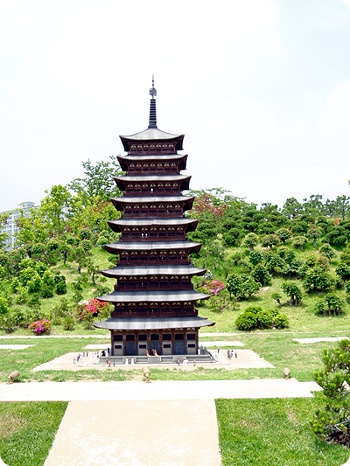- Hwangnyongsa
Infobox Korean name
 |caption=A miniature reconstruction of what the main pagoda may have once looked like.
|caption=A miniature reconstruction of what the main pagoda may have once looked like.
hangul=황룡사
hanja=linktext|皇|龍|寺
rr=Hwangnyongsa
mr=HwangnyongsaHwangnyongsa is the name of a former
Buddhist temple in the city ofGyeongju ,South Korea . Built in the 6th century, it was the center of state-sponsored Buddhism during theSilla andUnified Silla eras.http://books.google.com/books?vid=ISBN0791449416&id=wi_PfU1yancC&pg=PA149&lpg=PA149&dq=Hwangnyongsa&sig=lggdQlduSNijcz-S892q5nXsdis] Its name means "Golden/Yellow Dragon Temple" or "Emperor/Imperial Dragon Temple." Archaeological excavations and other scientific studies of the temple began in April 1976 (OCPRI 1984) and continue today.History
Hwangnyongsa was built during the
Silla period, under the patronage of the Silla royal family, on a plain encircled by mountains near the royal palace compound ofBanwolseong (Half-Moon Palace). Construction began in 553 under the reign of King Jinheung, and was not fully completed until 644. King Jinheung originally intended for the temple to be the site of a new palace but when a dragon was seen on the proposed site, a temple was commissioned instead. [http://www.orientalarchitecture.com/ Asian Historical Architecture: a Photographic Survey ] ] Hwangnyongsa was designed to be a place where monks prayed for the welfare of the nation by asking for the divine protection of the Buddha and a means to impress foreign dignitaries.Following the defeat of
Baekje in the 660s, the Baekje architect, Abiji, was commissioned to build a nine-story woodenpagoda at the site. This fact indicates that the Baekje had superior knowledge or wooden architecture. The nine stories supposedly represented the nine nations ofEast Asia and Silla's future conquest of those states.The pagoda stood until it was burned byMongol forces in 1238. No wooden architecture from the Silla people survives today but the ruins of Hwangnyongsa suggest aGoguryeo influence.http://books.google.com/books?vid=ISBN0750622679&id=Gt1jTpXAThwC&pg=PA716&lpg=PA716&q=Hwangnyongsa&vq=Hwangnyongsa&dq=Hwangnyongsa&sig=hiMUDjxVEe938FZSZioeaLY_eGg]The temple site in a valley within
Gyeongju National Park nearToham Mountain and about convert|150|yd from Bunhwangsa Temple, was excavated in 1972, revealing the temple layout and covering 40,000 artifacts. [http://www.asianinfo.org/asianinfo/korea/arc/three_kingdoms_period.htm Korea - Three Kingdoms Period ] ]Legends Surrounding the Temple
Buddhism was strongly resisted by the nobles of Silla while the king personally supported the new religion. The king's Grand Secretary,
Ichadon , suggested that he forge the king's royal seal and create an order that the people adopt the new religion. When the forgery was discovered by the nobles, Ichadon suggested that he be made the scapegoat and that through his death the power of Buddha made manifest. The king agreed to the plan. The nobles were predictably outraged when they discovered Ichadon's forgery and the king ordered his execution. When Ichadon was executed, a series of miracles occurred which proved the power and reality of the Buddhist faith and the nobles converted to the new state religion. Ichadon's sacrifice was the impetus to the building of Hwangnyongsa Temple.Another legend concerns the giant golden Buddha statue that the temple possessed. It was cast in the reign of King Jinheung as the temple centerpiece. The legend states that the gold for the statue came from King Ashoka of India. Ashoka had apparently attempted to cast a golden triad but failed. He then put the gold in a boat along with scale models of Bodhisattvas. Each country that received the boat was equally unable to cast the statues, and not until the boat had arrived in Silla could a statue be cast.
Dimensions of the temple
Only the massive foundation stones of the temple remain in current times. The original complex took seventeen years to complete.
*The main hall was convert|155|ft|m in length and convert|55|ft|m in width.
*The longest outer wall of the temple was 288 meters in length and the area enclosed by the outer walls covered approxiamately 80,000 square meters.
*The temple ruins also contain pedestle stones which were for monumental Buddhist statues. One statue of the Sakyamuni Buddha was five meters tall. [http://www.asianinfo.org/asianinfo/korea/scu/shilla_period.htm Korea - Shilla Period Sculpture (57 B.C.- A.D. 668) ] ]
*The temple was originally arranged in the "three Halls-one Pagoda" style which meant that the pagoda was in the center of the complex and flanked by three main halls on the left, right, and behind the central pagoda.
*The famous nine-story pagoda, which was commissioned by
Queen Seondeok after the main temple was finished, was the largest Korean pagoda ever built. It was reported to be convert|224|ft|m tall and the body was made entirely of wood. Only its foundation stones remain today but they attest to the mammoth proportions of the original structure. The pagoda had a foundation area of convert|6084|sqft|m2, was supported by eight pillars on each side, and had sixty foundation stones.References
*OCPRI (Office of Cultural Properties, Research Institute). 1984. "Hwangyong-sa Site Excavation Report I" [Hwangyong-sa Temple Excavation Site Report I] . Three Vols. Office of Cultural Properties, Research Insititute, Seoul.
ee also
*
Korean Buddhism
*Korean Buddhist temples
*History of Korea
*List of Korea-related topics External links
* [http://www.orientalarchitecture.com/kyongju/HWANGNYONGSA.htm Asian Historical Architecture profile of Hwangnyeongsa]
* [http://www.ikorea.ac.kr/english/notice_show.asp?idx=205 The Center for Information on Korean Culture]
* [http://whc.unesco.org/archive/advisory_body_evaluation/976.pdf#search='Hwangnyongsa' UNESCO]
* [http://www.jennyhouse.info/zboard/zboard.php?id=k_sang&no=50 Jennyhouse Architecture and Skyscraper Community of Korea]
Wikimedia Foundation. 2010.
